The Acer Swift 3 SF314 Notebook Review: Swift Gets Swifter With Ryzen 4000
by Brett Howse & Andrei Frumusanu on May 5, 2020 8:00 AM ESTSystem Performance
AMD’s new Renoir platform has already been showcased in our SPEC testing, which made a clear case that the new design provides a much-needed performance bump over the previous Picasso platform. Despite the individual cores having generally lower single-threaded performance than Intel’s Ice Lake, they make up for that deficiency with sheer volume, doubling the core count of the competition. AMD’s mantra for the entire Zen existence has been more for less, and that continues here again. Acer has positioned this laptop at an entry-level price, but with performance that should meet or exceed other devices in its class.
Both AMD based models of this 14-inch Acer Swift 3 come with 8 GB of RAM, in the DDR4-3200 flavor, which is where notebooks need to be these days for an entry position, so it was nice to see them offer 8 GB on both the Ryzen 5 and Ryzen 7 models. The company could have cut back to hit an even lower price point, especially on the Ryzen 5, but that would impact the performance too much to make it a worthwhile compromise. They’ve also started with a 256 GB SSD on the Ryzen 5 model, and bumped that up to 512 GB on the Ryzen 7 we have here, and still at just $649, which is fantastic value and should keep the target market happy for some time.
To see how the Acer Swift 3 with Ryzen 7 4700U performs, we have run it through our laptop test suite and compared it to several other similar systems. If you'd like to compare the Acer Swift 3 to any other laptop we have tested, please check out our online Bench.
PCMark
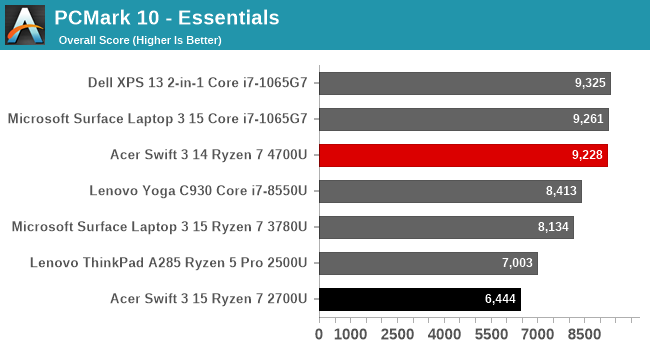
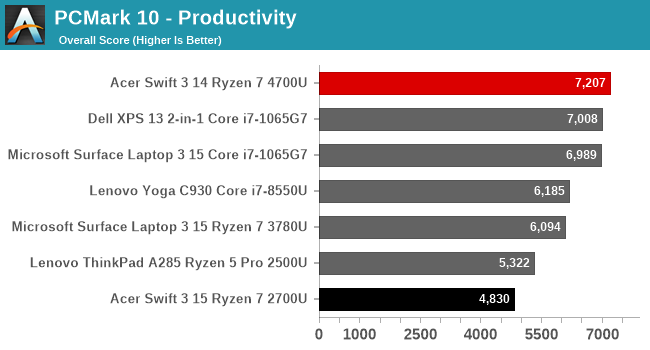
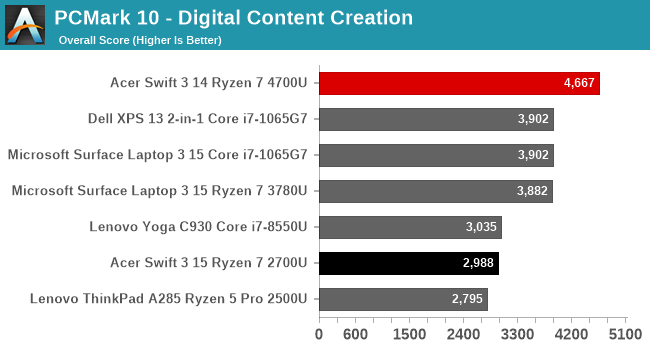
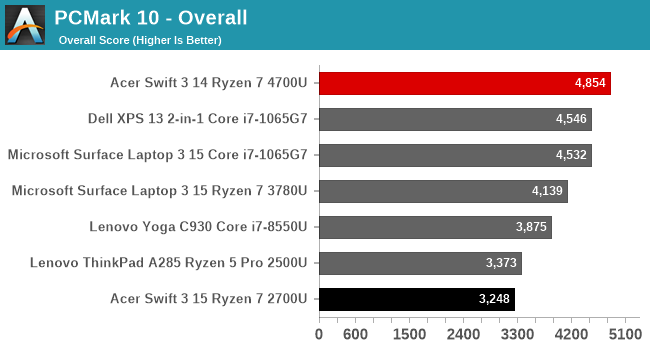
UL’s PCMark suite offers some real-world test cases, and tests all aspects of the system, from CPU performance, to GPU, to even app-loading times and disk performance. The Acer Swift 3 performs very well here, especially in the digital content creation sub-tests, where the GPU gets to showcase some of its prowess.
Cinebench R20
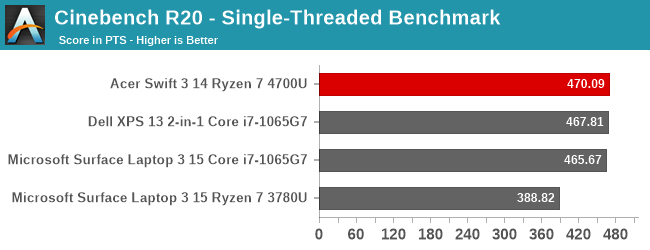
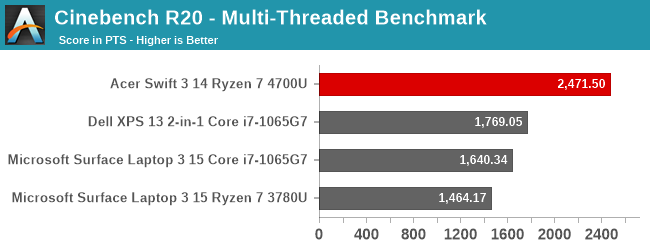
AMD has been touting its Cinebench results for some time since their launch of Zen, and for good reason. As a compute-focused test, the Zen 2 cores perform very well here, and having eight physical cores in the multithreaded results really make the Ryzen 7 4700U stand out. SMT has been a great way to get more performance per-core, but there is still no substitute for actual cores.
x264

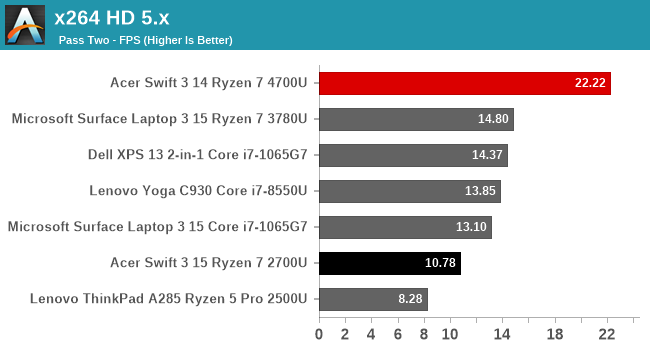
The x264 test transcodes a video using the CPU and has always enjoyed more CPU performance and more CPU cores, so it should not surprise anyone that the Ryzen 7 4700U wins the day here again. Eight cores make short work of this transcode.
Handbrake
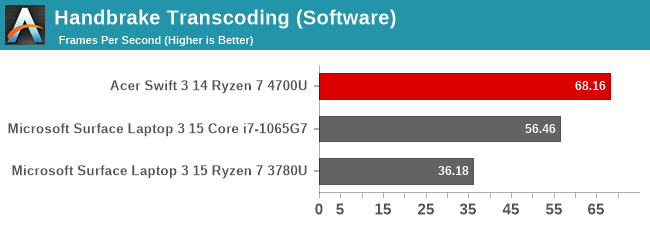

Handbrake is arguably the most popular video transcode tool around, and it offers both software-based CPU transcoding, as well as GPU accelerated. On our last Picasso platform, the Microsoft Surface Laptop 3, Handbrake wasn’t able to leverage Vega’s Video Core Next hardware, however the Acer Swift 3 can, and in both software and hardware encoding, the Renoir based Acer Swift 3 finishes this task very quickly.
7-Zip
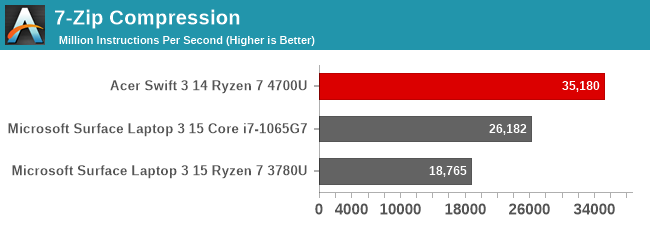
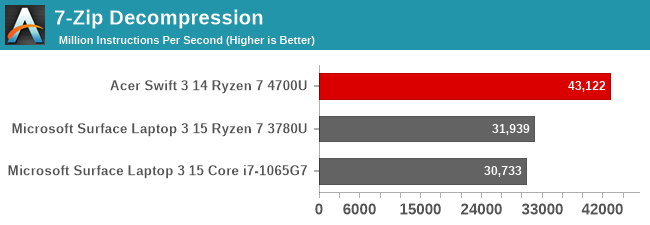
7-Zip is a very popular, free file compression and extraction tool, and it also offers a built-in benchmark. AMD’s Renoir SoC once again outperforms the rest of the 15-Watt systems here. Tests such as this and transcode do very well with the extra cores provided on the Ryzen 7 4700U.
Web Benchmarks
This will likely be our last review with the older web tests. Web benchmarks are as much about the browser’s scripting engine as they are about pure CPU performance, so for consistency we’ve tested in Microsoft Edge. Now that Edge is being moved to the new Chromium-based version, we’ll take this opportunity to replace some of our older tests.
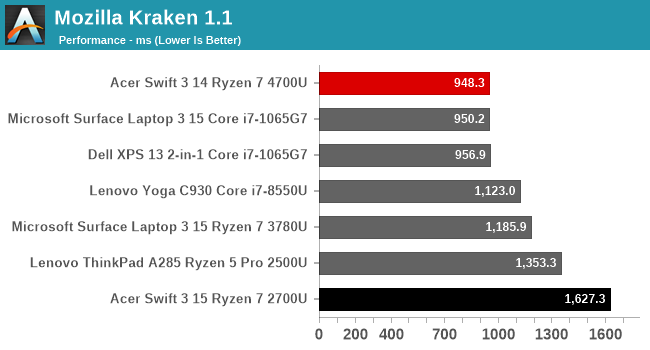
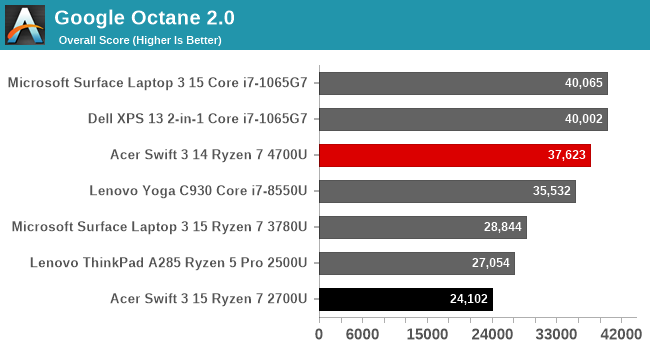
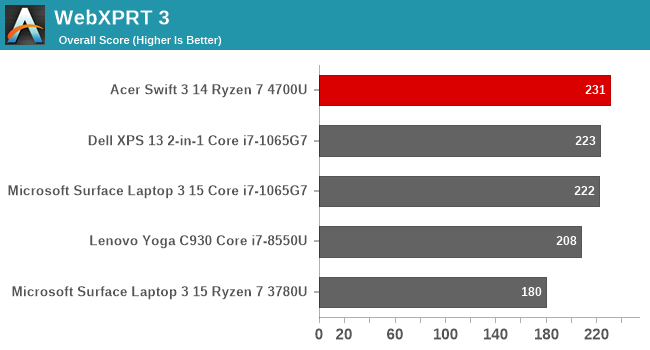
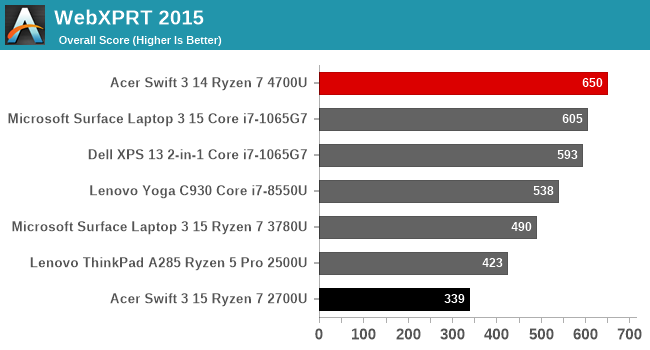
Web tests also tend to be more sensitive to the CPU being able to ramp up its frequency quickly, and that is an area where AMD’s systems did not perform quite as well. Luckily for Renoir, those issues are behind AMD, and the Acer Swift 3 performs very well.
Storage
One of the best things about the Acer Swift 3 is how much storage it comes with considering its price point. The review unit offers 512 GB of SSD storage, and although you may expect slower, cheaper SATA storage here, that is not the case. The Acer Swift 3 ships with NVMe PCIe 3.0 x4 storage, and in the case of the review unit, that means a Samsung PM991 SSD inside.
Performance is excellent. Despite this being a budget notebook, the storage options are very welcome. A base model offering 256 GB is a great start, but a proper NVMe SSD as well makes this laptop even more value.
System Performance Conclusion
Although AMD has really made inroads in the desktop space since the launch of Zen, in the laptop space where power is at a premium, what made the early Zen based APUs stand out was not the CPU but the GPU. Since then, Intel released Ice Lake, offering similar GPU performance but with much higher CPU performance. Now that AMD is on their third-generation of Zen-based laptop APUs, that performance lead has all but evaporated. In our SPEC results, Intel still has the single-threaded lead, but AMD more than makes up for that by offering eight CPU cores, compared to just four on Ice Lake. The Ryzen 7 4700U that Acer has fitted into this Swift 3 is likely to be one of the more popular options, and for good reason. Despite it not offering SMT, the performance is fantastic.


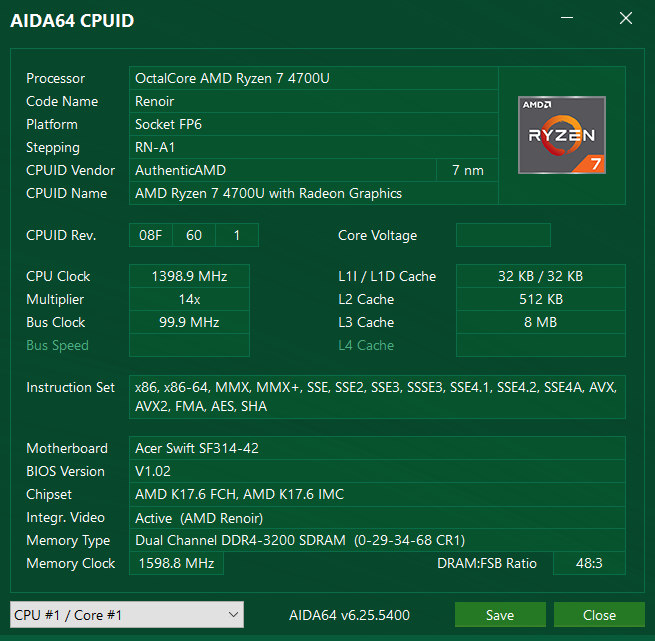









191 Comments
View All Comments
neblogai - Tuesday, May 5, 2020 - link
If you are interested in such things- check this video about the same laptop: https://youtu.be/awPI4RzKMvY?t=386 (use autotranslate). Basically- he put a thermal pads on the heatpipe so it transfers heat to the aluminum back cover. This allowed higher Cinebench result from cold and also higher and more consistent results in Cinebench loop. Before this modification- two of the 30 CB results were ~10% and 7% lower than others (4:40), while after the modding- all scores were higher, and without drops. Also- with this modification, bottom obviously got warmer, so this is not a solution for everyone.eastcoast_pete - Tuesday, May 5, 2020 - link
Thanks, that is an interesting review and modification. As you stated, the reviewer mentioned (assuming I can trust Google translate of the captioning) that this simple addition of thermal pads reduced the erratic thermal throttling a lot, and how little it would add to the BOM costs. Too bad Acer hasn't taken him up on his suggestion! I would pay an extra $5 for that; it's well worth it.anonomouse - Tuesday, May 5, 2020 - link
Any chance of memory latency and memory bandwidth comparison charts between the machines used in the SPEC2017 page? Would be interesting/useful to see these charts taking into account the performance on memory bound workloads, even if the Ice Lake part is using LPDDR4 and not DDR4 like the other two.wordlv - Tuesday, May 5, 2020 - link
Xps 13 runs @25w. This is known fact!hanselltc - Tuesday, May 5, 2020 - link
What the hell is the laptop doing with its thermal management? The SoC Temp FC5 just doesn't match up with the wattage it is drinking. Is the fan curve bad? Does the chip just flips out when it needs to balance CPU and iGPU powerdraw while it is hovering around the hard throttle temp limit?eastcoast_pete - Tuesday, May 5, 2020 - link
I found that link posted by neblogai a few comments up really informative! Apparently, Acer left a lot of potential, yet straightforward heat dissipation on the table.Hulk - Tuesday, May 5, 2020 - link
AMD is obviously on a roll but looking at these Ice Lake results I'd say Intel ain't dead yet. We have a fight on our hands!watzupken - Wednesday, May 6, 2020 - link
"AMD is obviously on a roll but looking at these Ice Lake results I'd say Intel ain't dead yet. We have a fight on our hands!"Firstly, I don't think it is a good comparison between a top end laptop running the top end Intel Ice Lake chip, and this low end Swift 3, running a mid high end Renoir chip. Top end laptops normally put in more care when it comes to cooling, and I believe this Dell model may be using a dual fan cooling solution despite its small and slim size. The cooling will certainly help improve sustained and burst performance, which in turn affect the benchmark scores. From my experience, Acer Swift 3 typically employs a single fan, single heatpipe cooling solution, which is woefully poor in cooling. If you look at some reviews out there on Ice Lake performance on lower end laptops, you noticed that the sustained clockspeed can go below 2Ghz, which will certainly hurt performance.
Secondly spec wise, the i7 and faster RAMs on the Dell will also give it an edge, against the Ryzen 7 4700U with slower RAM.
In this case, just as the review pointed out in the thermal section, I feel the Ryzen 7 4700U is actually very thermally limited to show its full potential. Hopefully we see other PC makers/ models that will provide better cooling.
Oxford Guy - Thursday, May 7, 2020 - link
Yes, if you limit the AMD chip to 8 watts:"The laptop really struggled with its thermals, dropping the framerate into single digits often. The device attempted to run at around 18 Watts of power draw, slightly over the 15 Watt TDP, but in fact only averaged around 8 Watts during this run."
supdawgwtfd - Tuesday, May 5, 2020 - link
"channels if your router is has the correct capabilities."Wanted! Proof reader/editor.